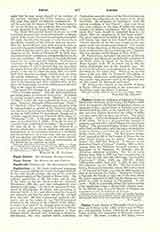

Paphos, titular see, suffragan of Salamis in Cyprus. There were two towns of this name, Old Paphos which owed its renown to the Phoenician goddess Astarte, as represented by a sacred stone or baetylus, and now identified with Kouklia, on the right bank of the Diorizo; and New Paphos, located at the village of Baffo, over nine miles distant from the former. The latter was the see. Under the Romans it was the metropolis of the island. In 15 B.C. it received the surname of Augusta, and was later called Sebaste Claudia Flavia Paphos. The proconsul Sergius Paulus resided there when Paul and Barnabas, after having confounded the magician Elymas, converted the governor to Christianity (Acts, xiii, 6 sqq.). The first known bishop, Cyril, assisted in 325 at the Council of Nicaea; for the other Greek titulars see Le Quien, “Oriens christianus” (II, 1059-62); Hackett, “A History of the Orthodox Church of Cyprus” (London, 1901, p. 314). Among them was Theodore (seventh century), the biographer of St. Spiridion, St. Nicholas, and St. Macarius, otherwise unknown. The list of Latin bishops from 1215 to 1597 has been compiled by Le Quien (op. cit., III, 1215-20); Du Cange “Les familles d’outre-mer” (Paris, 1869, pp. 865-68); Eubel, “Hierarchia cathol. need. nevi” (I, 40’7; II, 234; III, 287); Hackett (op. cit., 564-68). The last residential bishop, Francesco Contarini, who in 1563 had assisted at the Council of Trent, was slain in 1570 during the siege of the town by the Turks. During the Frankish occupation the Greek see was one of the four which the Latins supported in 1222, but the bishop was compelled to reside at Arsinoe or Chrysochou. It still exists. Baffo is a miserable village, the larger portion of its population living at Ktima half a league away. In the Middle Ages the Latin Diocese of Paphos was dependent on the Archdiocese of Nicosia.
S. VAILHÉ

